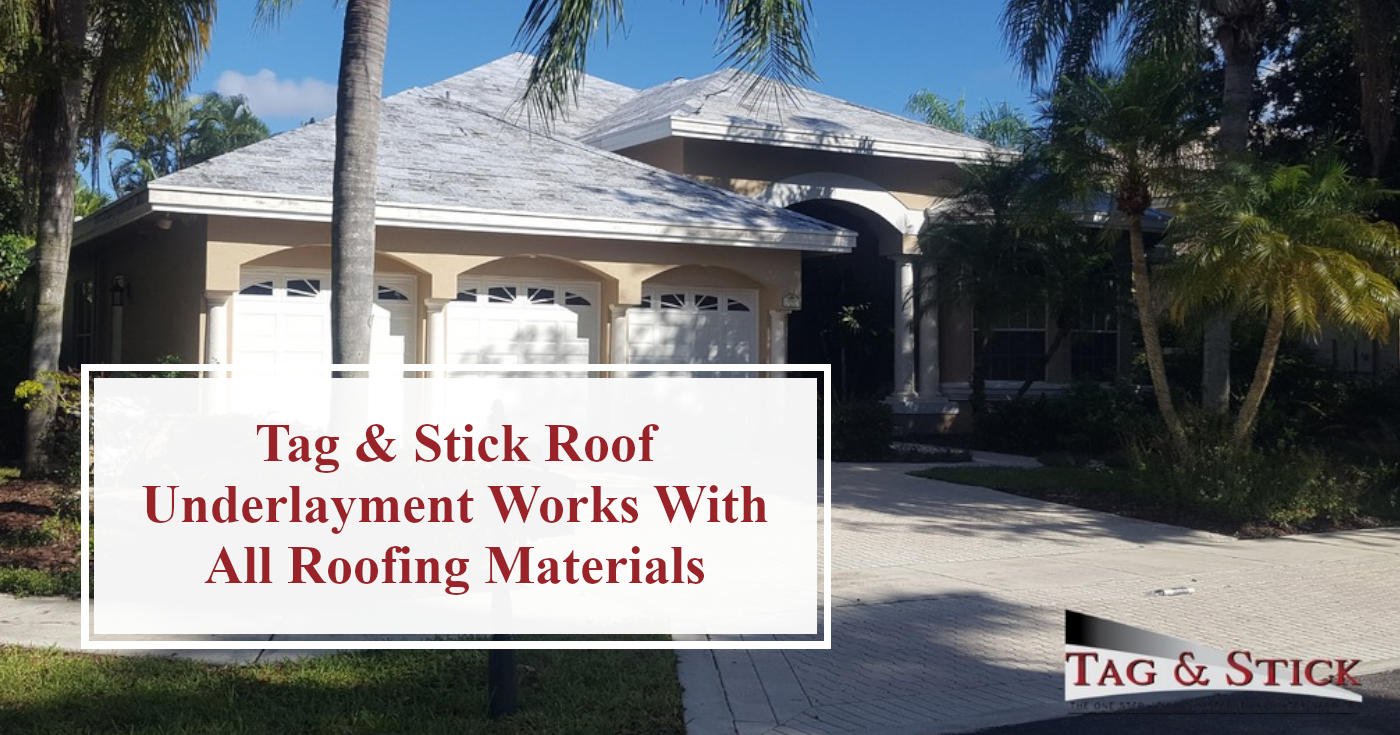Tag & Stick Roof Underlayment Works With All Roofing Materials

In most cases, the roof underlayment system a roofer will go with depends on the roofing materials that are used. Whether you’re doing a roof replacement or installing a roof for a newly built home, there are a range of roofing products that can be used.
This all depends on the style that you as the customer, or as the roofer are going for. Budget and local weather conditions will also play a big part in what materials are selected. The roof underlayment is an essential part of ensuring that the roof maintains a long lifespan, and keeps the home protected from external elements. Because there are many options for roofing materials, it’s important to use an underlayment system that pairs well with your selection.
Roofing Material Options
Not sure where to start? Let’s have a look at the different roofing options.
Asphalt Shingles
One of the most common roofing materials used for American homes are asphalt shingles. They are incredibly durable, hold well in strong winds, and are resistant in most environmental conditions.
Asphalt shingles are made from fiberglass, sometimes other materials, and then covered in asphalt. The shingle is then coated with stone and the back of the shingle is covered in sand. The sand at the back of the shingle helps the shingles stick together when installed on the roof. Asphalt is fire resistant, which is part of why they became so popular over the years.
Initially, the cost of installing asphalt shingles is low, however, with regular maintenance and upkeep, they have a lifespan of about 20-30 years.
Metal Roofing
Metal roofing systems are becoming a popular choice for homeowners, where previously, they were mostly used in industrial or commercial environments.
Selecting metal roofing has a range of benefits. They’re lightweight, low maintenance, and relatively inexpensive to maintain. They are a versatile style and design roofing option and come in a few color options.
Although they are a more costly option to install and are generally a bit more complicated, they have a long lifespan and are resistant to impacts from weather conditions. This makes the option more attractive for homeowners but will require a skilled roofer to carry out the job correctly, ensuring that the roof underlayment is done correctly and that the panels are installed expertly.
Flat Roofing
Flat roofing is known for its increased safety and is much easier to access for cases like maintenance, repairs, and cleaning. This is important because they tend to require more maintenance than other roofing systems. This is the case in areas that experience heavy rain, strong winds, and high temperatures.
They’re good for water drainage as they are not completely flat, but rather slightly sloped. Flat roofing does not last as long as other roofing does, with a general lifespan of 15 years before a replacement is needed. This makes it even more important, should you decide to go with this option, that the installation is done with an experienced professional.
Clay & Concrete
Clay and concrete tiles are an extremely hardy option for areas that experience strong winds and heavy rain such as South Florida. These types of roofs are able to withstand the wind strength of hurricanes and fare well in warm climates. It’s important to note that during maintenance, roofers need to be careful when walking on the roof as it does not carry weight very well.
Slate Tiles
Slate tiles give your house a classy finish. Slate has become an economical option and it is popular for its durability.
As most roofing systems need to be built for resistance, slate tiles fair well in high winds and heavy rains. Roofers need to be careful when conducting repairs and maintenance as any heavy foot traffic can cause damage. Slate tiles require very specific installation in order for them to last for an extended period of time and offer the safety a roof should. This also comes down to the type of roof underlayment that is used.
What Roofing Underlayment Works For My Roof?
There are a few underlayment systems that are used by roofing professionals currently. The three most commonly used systems include asphalt-saturated felt, rubberized asphalt, and non-bitumen synthetic.
While some roofers prefer to make use of a more familiar underlayment procedure, roofers should be using a system that offers the best solution for their clients such as Tag & Stick. While each underlayment system that has been used and developed over the years has its own advantages and disadvantages, Tag & Stick has combined all these elements to become the ultimate underlayment option.
This revolutionary approach can be applied to all types of roofing material and offers easy application. It requires a simple two-step installation process that avoids any dangerous chemicals and heat processes. The peel-and-stick method begins with a primary underlayment that is attached mechanically to the deck. A secondary sheet is applied which adheres through pressure-sensitivity which causes the lamination of these two sheets. This creates a two-ply barrier without any additional primary and preparation.
Not only that, it’s safe to use with all roofing systems and will not damage the sheathing if re-roofing is ever required. The benefit of this kind of application means that roofers can confidently offer their customers high-quality services no matter what roofing system they decide on for their home.
Interested In Using Tag & Stick For Your Next Project?
If you’re looking to revolutionize roofing materials for your customer’s, it requires using top quality, safe, and simple solutions. Shortening project time while maintaining a level of service should be a top priority for roofers. Learn more about Tag & Stick and how it can benefit your next project.